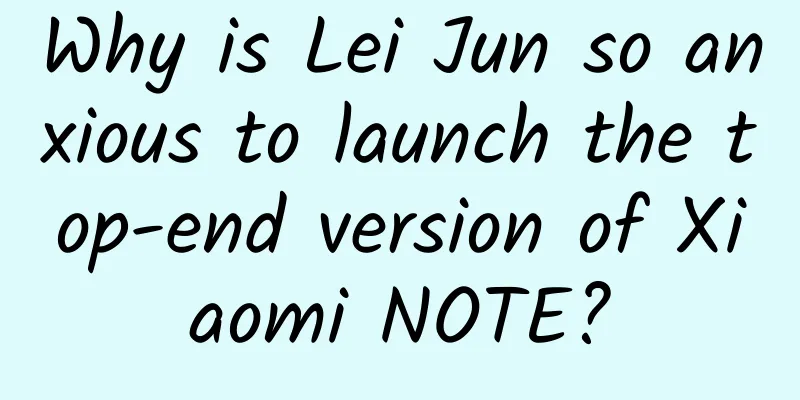Why is Lei Jun so anxious to launch the top-end version of Xiaomi NOTE?

|
Not long after the launch of Xiaomi Note, a top-end version was launched. Yesterday, Lei Jun stole the show with his friendly attitude at the experience meeting of this new mobile phone. Some people think that Xiaomi saw that its competitors were launching new products intensively, so it had to give them a try. This is common sense wrong. It is unlikely that a mobile phone will take several months from project establishment to release. Of course, knockoffs are an exception. Yesterday, Lei Jun revealed that the production of the top-end version of Xiaomi Note had already begun nine months ago. At first, he wanted to replace the motherboard, but the engineers refused to compromise. In the end, almost all the key components were replaced, and it became today's top-end version. This was by no means a temporary compromise, and it was impossible to accommodate it. However, it is too close to the release cycle of Xiaomi NOTE. It seems to be staggered by one quarter, but you have to know that this quarter is not the peak season for shipments. In terms of quantity, Xiaomi Note should still lack support. The launch of the top-end version at this time should have more implications. In my opinion, Xiaomi wants to achieve the following goals: First, further build the brand, especially create a high-end segment for Xiaomi to maintain a certain deterrent; Second, strengthen Xiaomi’s temperament, especially its technological temperament; 3. Create opportunities for internationalization in 2015. When I say high-end, I don't necessarily mean expensive. The top-end version of Xiaomi NOTE is only 2,999 yuan, which is only half of the price of Apple's iPhone 6 Plus. Even compared with Huawei M7, there is a significant price difference. However, from the perspective of hardware configuration, software matching and user experience, it maintains the dignity of Xiaomi's high cost performance. It should be said that it is clearly differentiated from other Xiaomi mobile phones. The Xiaomi brand is indeed moving upward. Xiaomi's patents have been questioned. Ericsson's blockade in India was once seen as an exposure of Xiaomi's shortcomings. Patent issues are actually not a shameful thing, as long as you use them in compliance. But one detail shows that Xiaomi will not be willing to be overly restricted on this topic in the future. Lei Jun revealed yesterday that the Xiaomi NOTE top version has more than 30 patents in the field of screen alone. At the end of 2014, Xiaomi co-founder and president Lin Bin revealed that the company would apply for more than 2,000 patents in 2015, and more than 4,000 by the end of the year. You can feel that Xiaomi is indeed trying to reverse a certain impression. Since the patent issue was related to Xiaomi's international layout, I think Lin Bin's original statement and the technical temperament revealed by the top-end version of Xiaomi NOTE yesterday seem to be creating a round of international public opinion opportunities for Xiaomi. From the perspective of its actual business layout, Xiaomi has indeed reached a window period for internationalization. Lei Jun said yesterday that Xiaomi is already the leader in the Chinese market, and will definitely make breakthroughs in the international market in the future. However, he did not disclose what role the top-end version of Xiaomi NOTE will play, nor the shipment target for the international market. Based on Xiaomi's product promotion activities in India, Hong Kong and other places in the past two weeks, my judgment is that in 2015, Xiaomi's international market should have a breakthrough in its quantitative base. In this way, Xiaomi in 2015 will create the following image in the industry, especially the capital market: it is experienced in the local market, has made breakthroughs in the international market, and has accumulated technology. In addition, Xiaomi has made layouts in various smart hardware, content, smart home, home decoration, and O2O service fields in the past period, which is another rhythm of raising valuation. I even feel that Xiaomi may break the logic of Lei Jun's original statement that it would not go public for 5 years. There are many different opinions about "5 years", because it has been nearly 3 years since Lei Jun first mentioned "next 5 years", that is to say, if 2015 is regarded as the first year of Xiaomi's internationalization, 2016 is a very critical window. Even if the goal is not achieved, it should not be delayed beyond 2018. Sources revealed that although Lei Jun has repeatedly emphasized that Xiaomi is the shipment champion in China, his vision has gone beyond China. Today, his benchmark companies are mainly Apple, and the number of times he mentions Samsung is getting less and less. In other words, he prefers to put Xiaomi on the international stage for valuation and benchmarking. This is partly because Xiaomi intends to strengthen its international market and also partly because it intends to improve Xiaomi's expectations in the future capital market. In this way, in a sense, the Xiaomi Note top-end version can even be observed as a signal flare. However, this does not mean that Xiaomi Note and its top-end version will definitely have outstanding shipments. On the contrary, I think that the more Xiaomi moves towards the international market and the more the Xiaomi brand moves towards the high-end, the more it will rely on the most basic and broad user base. In other words, the brand effect and signal created by Xiaomi Note and its top-end version will create greater business opportunities for Xiaomi's mid- and low-priced products. Guess which mobile phone product Lei Jun has the highest expectations for in 2015? People familiar with the matter said it was the low-priced Redmi 2A. He expected the shipment of this single model to be 20 million units, which is equal to 25% of the total annual shipment target. An industry insider said with a smile that Unigroup Technology might wake up laughing in its dreams, because Redmi 2A uses its solution. Xiaomi is enough to save this once struggling local design company, and it is not ruled out that it will be pushed to a higher position in the future. You can see from this that Xiaomi, as a company, has very shrewd pragmatism behind its speed and passion. It plays with sentiment and is also reshaping its brand, but most of its work and most of its products are high-cost-effective things that are close to the consumption level and consumption pain points of ordinary people. Many companies like to flaunt one of the two extremes. Hammer is too sentimental, but the concept is shattered by reality; Shanzhai phones are too good at catering to consumption trends, but lack quality and a healthy ecosystem, so they can only go through life and death and experience repeated reshuffles. Xiaomi's positioning is based on its ecological model, and triathlon plays a huge role. Recently, some analysts have been disparaging the term "ecosystem", thinking it is empty and the key is to make a good hardware. Yesterday, Zhou Hongyi himself also made fun of this term. I think this is all short-sightedness in the mature stage of the industry. The mobile phone ecosystem is of course based on the terminal, extending to various stakeholders upstream and downstream, and ultimately reflected in the implementation of services and a sustainable business model. What I find hard to understand is that Zhou Hongyi, who had experienced the setbacks of mobile phones, actually thought that as long as he made a good hardware terminal, everything would be fine. From his cognition yesterday, I remain cautious about the future of Qihoo. I hope that he was making fun of Lei Jun, Jia Yueting and others, and his language was distorted. Even if he praised Apple, if there was no software system and Internet services, would the iPhone be so popular? Apple's hardware profit model is based on software services. Think about it, if there is no Internet service, what is the meaning of the high-priced phone? Of course, Xiaomi's ecosystem is not perfect. There are some accidents in its rise. It is also unable to play without some key links. At least for now, it is still difficult for Xiaomi to get out of the model of terminal shipment-driven growth and rely on services for profit, and the results cannot be seen in the short term. Once shipments are suppressed, Lei Jun will certainly be anxious. In fact, he has been anxious enough in the past two months, especially in March. Sources revealed that Xiaomi's shipments in March were lower than Lei Jun expected, and he himself did not expect it to be so low. In April, Xiaomi's shipments reached 6.91 million units. Lei Jun is slightly satisfied, but in the annual shipment target of 100 million, he obviously hopes to be in the second half. There are some unclear trends, and Lei Jun must have noticed them. Please think about a few similar sentences from a company, there is something interesting in them: 1. Lei Jun said yesterday that the top-end version of Xiaomi Note was launched a month later than it was originally launched; 2. On the afternoon of April 23, Yu Chengdong said at the Honor P8 Shanghai "Like Water Flowing Years" press conference that the product was one month later than originally expected; 3. On April 14, Jia Yueting said at the LeTV mobile phone launch conference that the product was one month later than it was originally launched. If we also take into account the much-hyped but least-effective Dazen mobile phone - Zhou Hongyi's failure to come up with a new mobile phone - it at least shows that the entire market seemed to be in a state of "delay" in May 2015. Most of them explained that the product experience was not good in some aspects and needed to be optimized or repaired, which delayed the launch. However, another urgent crisis was obviously getting worse, that is, the mobile phone supply chain was very tight. Sun Changxu, a well-known communications industry media person, disclosed a piece of news on May Day, saying that Lei Jun and other Chinese mobile phone tycoons lined up to go to Sony in Japan to ask for sensors, and mentioned that Sony's camera chips, especially 214 chips, were in serious shortage. In April, the highest-level customers such as Xiaomi and Huawei could only meet 50% of the demand, while OPPO, ZTE, Coolpad, Gionee, etc. could only meet 10-30%. Other companies basically could not get quotas, and it was even worse in May. Many people saw that Xiaomi's Q1 shipment growth rate declined slightly, and then asserted that it was starting to go downhill, without seeing the upstream trends. Of course, the period after the Spring Festival is indeed the slowest season of the year. Lei Jun is also worried about the supply chain. He did not deny the news that he went to Sony in Japan to buy goods. However, from the shipment of Xiaomi and the new trends of Xiaomi Note and top-end version, you can feel that Lei Jun can handle the upstream. Otherwise, don't play in 2015. This must be one of the focuses of many manufacturers' competition. I still believe in the philosophy of shipment strength. That is to say, supply chain issues are based on shipments. The company with strong shipment capabilities and high expectations has stronger control over the supply chain. This is true for Apple, Samsung, Xiaomi, and Huawei. If this wave of supply crisis continues, some brands may even face a huge crisis. We have seen some Internet companies start to make mobile phones. Rather than saying that they are proactive, it is better to say that some traditional brands have been unable to keep up with the pace and are facing huge challenges. Xiaomi has a shipment forecast of 100 million units, and its growth over the past five years has been proven, and it has established a trusting relationship with upstream suppliers. This gives it a better bargaining basis than some new brands. If this crisis continues, it may bring more market opportunities to Xiaomi. Of course, Xiaomi is also facing the impact of new ways of playing. Zhou Hongyi announced yesterday the mobile phone development model of equity crowdfunding. This is indeed innovative. It reveals a spirit of open operation, which shows that Zhou Hongyi is not bound by the past model. It is worthy of praise and I believe it will have a considerable effect. The mobile phone industry has developed to the present, and the technical threshold is very low, but the capital, ecological and commercial thresholds are very high. You can quickly make some mobile phones, but if you want to quickly achieve mass production and reach a certain shipment scale, you need to invest more and it is much more difficult than in the past. Not long ago, LeEco announced that its mobile phone business was not within the listed company, which only held 19% of the shares. This seemed to convey that it would not bring more financial pressure to the listed company. I believe that Zhou Hongyi's Qihoo is unlikely to be supported by more listed companies. As of now, Qihoo 360's cash strength is also limited. The equity crowdfunding method may at least alleviate the capital pressure. In addition, it may also gather the first batch of hardcore fans for it. But Qiku is far from being validated by the market. Please remember that Coolpad is not equal to Qiku. Moreover, although Coolpad has certain competitiveness, it is also full of uncertainty in the new round of competition. If it develops well independently, how can it accept 360's olive branch? So, when I found that Zhou Hongyi spent nearly one-third of yesterday's time making fun of Xiaomi and Lei Jun, it actually revealed a kind of lack of confidence. He is actually helping Xiaomi and Lei Jun create a greater reputation. Xiaomi is indeed not perfect, but at least in terms of commercial effectiveness, at present, among local companies, except Huawei, I really can't see its real opponent. Xiaomi rose in a trend, and some say it was the outlet of the wind. There is indeed a change of the times, and Xiaomi closely caters to this trend. You may be able to integrate 80% of the resources similar to Xiaomi, but in the end you will find that when you sprint with all your strength, the times you are in have changed. Making fun of Xiaomi is like looking for a sword in a boat. I will re-post my views from last week. The rise of Xiaomi is mainly due to the following five points, which contain unique characteristics of the times. 1. Xiaomi is essentially a software company. This is related to Lei Jun's past years of experience. In this way, when he thinks about problems, he will not fall into hardware thinking, but will have the awareness of grafting services from the beginning. Don't forget that the Internet is also a service in the form of software. If Lei Jun did not have many years of experience in the software industry, he would not be so successful. I dare to assert this. His initial confidence lies in software (including systems), and now of course it is much richer. Coincidentally, if Jobs had been kicked out of Apple and had not had that experience at Pixar, he probably would not have been able to see Apple's real crisis and future. 2. Xiaomi has the efficiency of a copycat, and it is the biggest beneficiary of the "post-MediaTek era". The greatness of Shanzhai lies in its efficiency and the same contractual spirit as that of folk gangs. Of course, Shanzhai efficiency often comes at the expense of quality. Xiaomi's efficiency does not mean that it can supply a few models of machines a year, but that it can use limited machines to operate a large scale. Faced with many materials, technical functions and options, it can quickly coordinate and has strong bargaining power. This is related to its ability to define products. Lei Jun's advantage is that he has the thinking of a product manager who puts himself in other people's shoes. Faced with this kind of choice, if a general enterprise negotiates with each customer, by the time a result is reached, the market may have lost its appeal. Mobile phones are fast-moving consumer goods. Efficiency is reflected in the mobilization of materials and quality OEM companies. I used the adjective "quality" because only with this word can we know what is truly valuable efficiency. Xiaomi mobile phones have many problems, but at this stage, it is an all-around champion, a company that combines efficiency, quality and price relatively well. 3. Healthy, large-scale, and fast-turnover capital flow. The copycat group can still operate with such low gross profit because, first, the market scale is large enough, and second, the capital turnover efficiency is high. The secret of this group is that the real industry will gradually become stronger, and the real strong capital flow. There are many supply chain finance players in it. We can even say that Foxconn is also an awesome supply chain finance company, with both positive and negative effects. Xiaomi's capital turnover is very fast and efficient, which is the core of its mobilization of the industrial chain. If Xiaomi has no money and no financial leverage, it will not be able to play; 4. Word of mouth, fan economy, brand, value chain. This is overused. It's not that Xiaomi is so awesome. Many people have already used the methods in "Sense of Participation". Apple is more mature than it. However, Xiaomi is the only local company that has consciously and consistently done this from the beginning. This involves the thinking of the founding team, and will eventually form efficiency; 5. Business model and value chain. I won’t talk about the business model because it is the most intimidating. It is better to know that Xiaomi is an e-commerce company than a mobile phone company. Xiaomi has a variety of products, but its products are scattered in form but not in spirit. If you want to understand it, you can get very interesting results by investigating its accessories industry chain. All in all, Xiaomi is the product of the improved efficiency of China's current smartphone industry. Or let’s put it this way: Xiaomi = copycat-like supply chain efficiency (a product of the post-MediaTek era), awesome capital turnover efficiency (e-commerce characteristics), Apple-like marketing and communication efficiency (learning from Apple’s good example). You can see the shadows of many companies in it. Some people say it plagiarizes everywhere, but it should be said that it has a strong learning ability and has absorbed the advantages of many companies to form its own style. It is easy for a company to be deified, but in many cases it is not the company itself that deifies itself, but the competitors. They only see the similarities between Apple and Xiaomi and themselves. Many companies can control this part, just like the platforms of MediaTek and Android, which can easily find solutions. But beyond this, you will see that the business environment and time and space you created have changed, consumer behavior habits have begun to change, and the growth driver of the entire industry has also shifted. Under this situation, your only competitive trait is: after you have the resources such as team and technical capabilities, do you have a stronger learning ability, especially the ability to learn the strengths of your competitors, and dare to break the past, coordinate and integrate them into your own independent framework, instead of shouting the names of Apple and Xiaomi every day, "I will defeat you." It is important for every enterprise to know both the enemy and yourself, but without a period of greater fool experience, no matter how awesome a person is, he will not have a great future. For example, Zhou Hongyi's use of equity crowdfunding to develop mobile phones is worthy of encouragement, but there is no need to spend a third of his time making fun of Lei Jun and Xiaomi. Xiaomi rose in the previous period of openness and trend, and 360 is in a different window period. It should consider how to accelerate its landing and establish an O2O-based in-depth market. Of course, 360 is a listed company, and it has to consider its stock price and its security business that is being disrupted by Tencent and Baidu. Equity crowdfunding may just be a means for 360 to increase its stock price. This is what I want to say to all local mobile phone companies, including Xiaomi. In the short and medium term, in order to sprint shipments, you can yell at your competitors and attack their weaknesses to promote your own shipments. However, this world is so small in terms of population and space. Even if you change your phone every year, you will always reach a shipment bottleneck in the future. You must always consider transitioning from a shipment growth-driven model based on horizontal market space to a service growth-driven model that relies on vertical and in-depth growth. Some time ago, someone compared Xiaomi to a department store. I think this is a bit off the mark. I agree with this: among all global mobile phone companies, including Apple and Samsung, Xiaomi is closest to the people and meets their needs the most. My judgment is that its future should be a vertically integrated O2O company that affects the lives of the public. Although it is based on the software and hardware ecosystem, it provides services that link various landings. It is much deeper than the concept of "selling goods". Looking back, looking at the release of the top-end version of Xiaomi Note yesterday and Xiaomi's recent developments, I feel that this company still has a long way to go. Immersed in external myths, or worried about various jokes, and deviating from the combination of sentimentality and pragmatism, that is the real crisis for Xiaomi. As a winner of Toutiao's Qingyun Plan and Baijiahao's Bai+ Plan, the 2019 Baidu Digital Author of the Year, the Baijiahao's Most Popular Author in the Technology Field, the 2019 Sogou Technology and Culture Author, and the 2021 Baijiahao Quarterly Influential Creator, he has won many awards, including the 2013 Sohu Best Industry Media Person, the 2015 China New Media Entrepreneurship Competition Beijing Third Place, the 2015 Guangmang Experience Award, the 2015 China New Media Entrepreneurship Competition Finals Third Place, and the 2018 Baidu Dynamic Annual Powerful Celebrity. |
<<: SKYWORTH GLED Air G7200: Salute to the backbone of the times
>>: It’s a difficult situation for Master Zhou. Is there any hope for Qihoo 360?
Recommend
Taking daily chemicals as an example, how to make your information flow copy stand out?
The products in the daily chemical industry gener...
The Expendables 8.7 Tutorial on how to automatically create a Douyin account on your iPhone! Easily help you solve the problem! 7
The Expendables 8.7 Tutorial on Automatic Account...
What is image promotion? How to do image promotion?
In the Internet age, image display ads are becomi...
What should we do when entrepreneurial blind spots appear frequently?
Four dead corners of entrepreneurship On the even...
In the hot summer, there is an "otter" that is super sweet! Do otters have their own "bubble effects" when swimming in the water?
The temperature in Nanjing has soared to over 30 ...
PC WeChat article one-click export assistant_resource cat, green software download station
A free WeChat article export tool that can export...
User retention: Talk about the psychological routines that make users unable to stop
The strategic essence of an effective business mo...
Millennium Populus euphratica, is it really 1,000 years old?
Your browser does not support the video tag It is...
Labor Day is coming, here are ten sentences
May Day is coming, and the short holiday is comin...
Brand marketing promotion: How to learn the product placement of "The Debaters"?
Since its inception, product placement has faced ...
Rao Zihe: Fighting against the "invisible enemy" to protect life
Your browser does not support the video tag Life ...
How much does it cost to develop the Honghe pregnancy and childbirth mini program? What is the quote for developing the Honghe pregnancy and childbirth mini program?
According to industry insiders, mini programs wil...
The conversion rate of information flow is only 10%, so where does the remaining 90% of traffic go?
The most painful thing in marketing promotion is:...
Will artificial rainfall increase pollute the environment? You may have misunderstood. It is not possible to increase rainfall just because you want to.
During droughts, will relevant departments carry ...
How did Qutoutiao gain 100 million users through fission?
What is the relationship between Qutoutiao and To...




![[Popular Science of Chinese Military Technology] Can the "digital life" in "The Wandering Earth 2" break through the dimensional wall and shine into real life?](/upload/images/67f243a5531e3.webp)



![[Popular Science of Chinese Military Technology] What was the first “hidden killer” planted by humans in space like?](/upload/images/67f23414909c3.webp)
